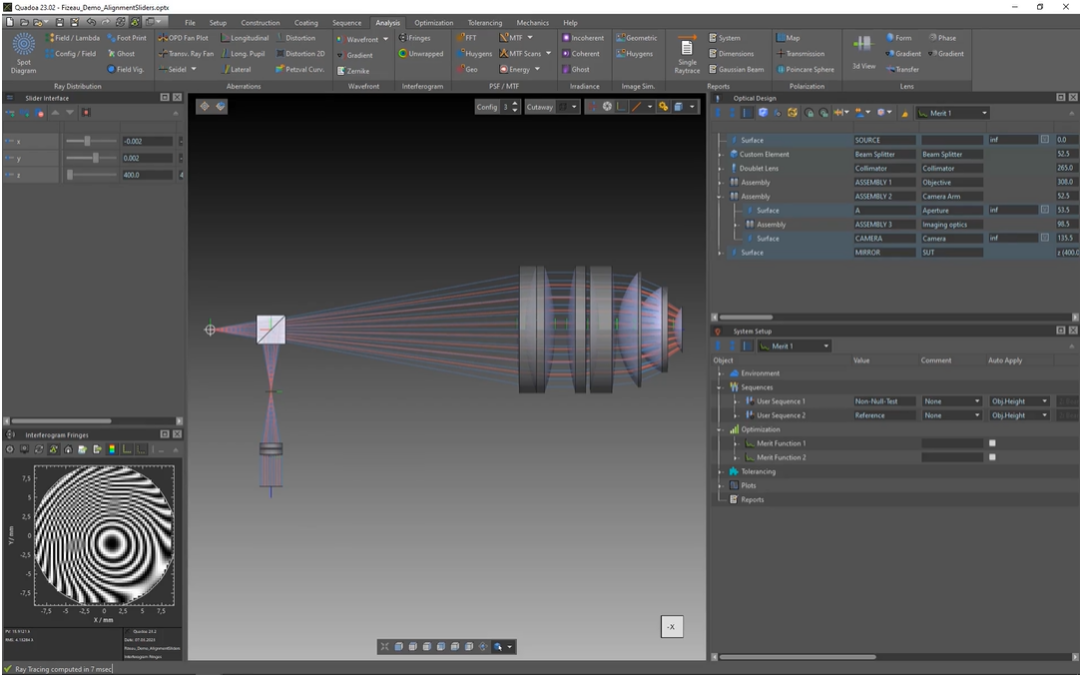Multiple Merit Function Optimization
Learn how to optimize multiple merit functions and sequences simultaneously.
Transcription:
In this video, I will show you how to set up multiple merit functions.
What is the advantage of setting up multiple merit functions?
So first, it is possible to set up a unique merit function for individual assemblies or elements.
This is of great importance, for example, for larger optical systems, which consists of several assemblies or of several elements and multiple ray paths as, for example, here this FISO interferometer.
For example, here in this FISO example, you want to optimize for the wave front error of the whole interferometer, and you also want to optimize for the imaging quality of the imaging optics, which you can see here, for example.
Another big advantage is in the case of comparison of two different system configurations to check which configuration performs the best. And a third very important point is that it is possible to define multiple merit functions for tolerancing. For example, one merit function only for the evaluation of the optical performance and one merit function for the compensators and so on.
And to show you how to define multiple method functions, I’ve set up here this simple system with those two assemblies, the first assembly containing the stoplight lens and the second assembly containing here the singlet lens, and I’ve defined two sequences. One sequence which is going here until the first surface of the second lens highlighted here in red and the second sequence which is going through the whole system.
And I will define two merit functions, and the first merit function will be optimized using the first sequence and the second merit function will use here the second sequence. To add the merit functions, we go here to the system setup and click here with the right mouse button on optimization, and there we click on add merit function.
In my case, I will add two merit functions.
So the first merit function here for the first assembly using the first sequence and the second merit function using the second assembly with the singlet in the second sequence.
To define the merit function, I will open the merit function here. There, I will define the ray trace here, the sequence one.
The second merit function, the same, but I will, select the sequence two.
The next step would be to define the ray tracing goals.
So in my first merit function, I would like to collimate the rays, and in the second merit function, I would like to focus the race onto a single point. So in the next step, I will define the merit functions with the targets and the constraints.
In the next step, we will define the variables for our optimization, and for that, we go to the optical design editor, select here down from the drop down menu the merit function for which we would like to, define the variables.
So first, I would like to define the variables for merit function one.
Then we open the assembly, which would should like to optimize with the merit function one, and then we just select here the check boxes in order to set those parameters as a variable.
In the second step, I will set up the variables for the merit function two. So again, I go here to the drop down menu, select merit function two, then I go here to the singlet lens, which will focus the rays on a single point, Open here the singlet lens, and then I will select here the variables.
So now we have to find the merit function and set up the variables, and now we can optimize our system. And for that, we go to the optimization tab and open, for example, here this local optimization. And here in the local optimization wizard, we select the merit function which we would like to optimize. In my case, I would like to use first the merit function one to optimize here this doublet lens in order to collimate the rays here with the first sequence colored in red.
And as you can see now, the red sequence here and the the lens has been optimized and the rays are collimated.
And now again here in the optimization wizard, I will select the merit function two in order to optimize here the second assembly with the singlet in order to optimize the sequence that the rays will focus on a single point.
Yeah. And as you can see, we have optimized our system with two unique merit functions, one merit function for each assembly and using two different sequences.
Yeah. This was my short tutorial about using multiple merit functions for the optimization and using multiple sequences for the optimization.
Thanks for watching.
